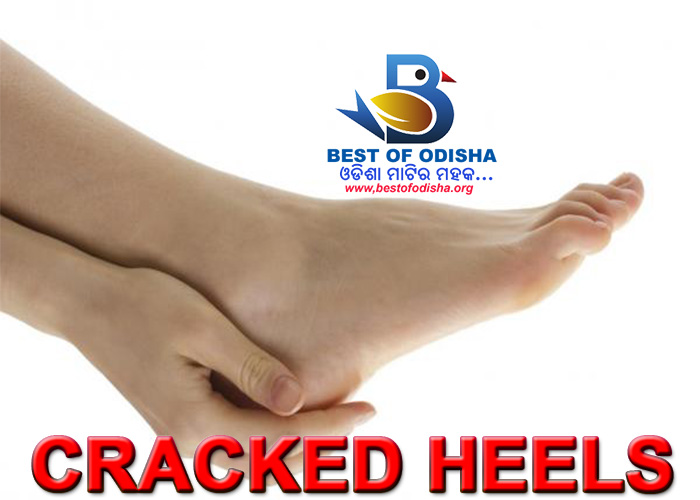Cracked heels are a sign of lack of attention to foot care rather than just overexposure or lack of moisturizing. Medically, cracked heels are also known as heel fissures. Fissures are regular linear cut wounds and mostly affect the surface level which comprises of the epidermis. Sometimes it may get deep into the dermis and become painful. Excessive pressure on the feet pads make the feet want to expand sideways. As the skin, surrounding the sides of the feet are dry they crack and cause cracked heels. Appearances of dry cracked heels also indicate zinc and omega-3 fatty acid deficiency.
Though cracks in the skin may arise anywhere in the body the most common is area is the rim of the heel and web of toes, which happen to be the most frequently or constantly used parts of our body. Dry skin or xerosis is one of the most common causes that lead to cracked heels .The other key reason being thick or callus skin around the rim of the heel. Most of the foot problems arise due to neglect and oversight with regard to feet care. Cracked feet, corns and other common feet ailments can be attended to and are easily avoidable.
Cracked heels are not a harmful in anyway except when the fissures or cracks are deep, and tend to become painful and the skin begins to bleed. This could lead to infection and is an avoidable situation mostly for those already suffering from chronic ailments such as diabetes or lowering immune system due to age or illness which may retard the treatment of cracked heels.
Cracked heels are a common occurrence for senior citizens or people who are constantly on their feet thus exerting pressure on the feet pad. In addition to this, sebum production decreases with age and so seniors tend to suffer from dry and cracked heels. Excessively dry skin, peeling skin, and dry and cracked skin on the heels are some of the most common skin problems that seniors face. Dry skin on the heels is often a recurrent problem. It can affect either both the heels or one of the heel. But most commonly, cracked heels affect both the feet.
Symptoms for Cracked Heels
Signs and symptoms that surface on the skin are simple indicators of a faulty internal activity or an external abuse. If one observes the body and its manifestations minutely one can avoid disease and disorders by treating them before they take on a destructive path. Similarly, feet care calls for a little attention and when the feet finds it lacking they indicate the following signs to show the feet could do well with some care.
• Red or Flaky Patches: This is often one of the first symptoms of dry cracked heels and if it is ignored, the condition may worsen in time. Dry skin is also vulnerable to dry skin infections and so it is important to treat the condition right away.
• Peeling and Cracked Skin: This symptom generally follows the first symptom of red or flaky skin. Peeling and cracked skin is a definite sign of dry cracked heels and immediate measures must be taken to remedy the condition. Make sure that you do not try to pull off the pieces of dry skin as this could damage the skin it is attached to. If you need to get rid of a long piece of dead sin you can use a small pair of scissors to slowly and carefully clip away the dead skin.
• Itchy Skin: Itchy skin is caused by the abnormal shrinking of the upper layers of dry skin. This excessive shrinking causes the stretching of the skin below and around the affected areas and this results in general discomfort and itchiness. You will have to get rid of the upper layers of dead skin before you start any type of treatment for dry cracked heels.
•Bleeding or Discharge from Cracks: Bleeding or discharge from cracks in your heels is a very serious problem as it indicates that the cracks not only affect the upper layers of the skin but also the lower layers of tissue. Deep cracks in the heels will also increase an individual’s risk of suffering from a skin infection in this area. Wearing closed shoes without socks while you have dry and cracked heels will only serve to further increase one’s risk of suffering from a dry and cracked heels fungus infection as closed shoes provide fungus and yeast infections with the perfect habitat to reproduce.
Causes for Cracked Heels:
• Naturally dry skin or thick dry skin (callus) around the heel that is more likely to crack is often due to excessive feet activity.
• Prolonged standing at work or home .Hard floors may also cause cracks in the feet.
• Being overweight may increase the pressure on the normal fat pad under the heel, causing it to expand sideways and if the skin lacks flexibility the pressure on the feet lead to cracked heels.
• Back-open sandals or shoes allow the fat under the heel to expand sideways and increases the possibility of cracks on the heels.
• Disease and Disorders-Athlete’s foot, Psoriasis, Eczema, Thyroid disease, Diabetes and some other skin conditions may also cause cracked heels.
• Continuous exposure to water- Water, especially running water, can rob the skin of its natural oils and this can leave the skin dry and rough. Standing for prolonged periods in a damp area such as a bathroom can cause dry and cracked heels.
Here is a list of some other reasons that may lead to cracked heels:
• Age – Thick dry scaly skin lose elasticity with age and thus cracks have higher incidence with age.
• Ill fitting shoes, standing for a long time or change in walking posture.
• Unhygienic circumstances or conditions
• Unhealthy, dry scaly skin due to climate or diseases
• Deficiency of vitamins, minerals and zinc
Remedies for Cracked Heels:
• Apply any shortening or hydrogenated vegetable oil after washing the feet clean on dry and cracked areas of the feet. After applying a thick coat of shortening on the feet, wear a pair of thick socks. Leaving this application overnight can surely provide positive results in few days.
• Apply the pulp of a ripe banana on the dry or cracked area of the heel. Leave it on for 10 minutes and rinse it clean. This is a simple dry cracked heels home remedy and it can be used on a daily basis to prevent and treat dry and cracked heels. You can also add half an avocado or the flesh of half a coconut to a blender along with the banana to form a thick and creamy paste. Avocados and coconuts are rich in several essential oils and fat soluble vitamins. This paste will help to provide your skin with the vitamins and oils it requires to stay soft and well moisturized. This paste can be used to treat as well as prevent dry cracked heels.
• Soak the feet in lemon juice for about 10 minutes. Follow this therapy on a weekly basis until one finds a change. Lemon juice is a very mild natural acid and helps to dissolve dead and dry skin son that it can be easily removed. It is best to soak your feet in a lemon juice solution and then lightly scrub it with a loofah or soft foot brush to gently exfoliate the top layers of dead skin that cause dry cracked heels.
• A daily regime of cleaning and moisturizing is a good cure for dry or cracked heels. At the end of the day soak the feet in warm soapy water for about 15 minutes. Rinse feet and pat dry. Make a healing mixture comprising of: one teaspoon Vaseline and the juice of one lemon. Rub this mixture onto the cracked heels and other required areas of the feet till it is thoroughly absorbed. This can be done daily until visible results are obtained. It is best to apply this mixture to your feet right before you go to bed. You can then pull on a pair of thick woolen socks to protect your linen from getting stained. Furthermore, the woolen socks will help to trap your body heat and this will increase the effectiveness of the mixture as more of it will be absorbed by your skin. You can exfoliate your skin before and after you use this mixture. The oils in this mixture will help to soften dry and cracked heels and this will allow you to easily slough off the dead skin the next morning.
• A regular application of a mixture of glycerin and rosewater is known to soothe and cure cracked heels.
• Another result oriented solution is to melt paraffin wax and mix it well with little mustard oil. Apply on the dry or cracked area of the heels. Rinse it off in the morning. A continuous application for 10 to 15 days can achieve desirable results.
• To get rid of the dry skin on your heels, you should exfoliate your feet on a regular basis. Avoid harsh cosmetic exfoliating scrubs and instead you can make your own gentle and natural scrub with honey, apple cider vinegar, and rice flour. You will fist have to grind a handful of rice until your get a fine but coarse flour. After that, add a few spoons of raw honey to the mixture along with enough apple cider vinegar to obtain a thick paste. If the cracks are very deep, you can add a spoon of olive oil or sweet almond oil to the paste. Soak your feet for 20 minutes and then gently massage them with this paste. The vinegar in this cracked heel treatment will help to dissolve the thickened layers of dead skin while the rice flour will gently abrade the top layer of dead skin. Honey and olive oil act as natural moisturizers and will help to keep the skin on your feet soft and moisturized and this will prevent further cracking.
• Many cracked heel repair creams that are avoidable in the market today contain chemicals that can aggravate your skin and increase discomfort. You can make your own moisturizing cracked heel cream by mixing together a spoon of olive oil along with a few drops of lemon oil or lavender oil. Pour this blend of oils into a small bottle and add an equal amount of water to it. Shake the contents thoroughly so that the water and oil form a thick milky solution. Use this homemade remedy for dry cracked heels as and when it is needed. Make sure that you shake the solution before you use it.
Diet for Cracked Heels:
Consume a Diet Rich in Calcium, Iron, Zinc and Omega-3 Fats
Cracked heels are caused by deficiency of vitamins, minerals, zinc and omega 3 fatty acids. Therefore it is essential to have a diet rich in vitamins, minerals and zinc. Omega-3 fatty acids are not naturally produced by the body, therefore it has to be ingested from food or supplements.
Here is list of essential foods that one can include in a regular meal and help curb deficiencies that may cause cracked heels:
• Vitamins (Vitamin E) rich foods include: vegetable oils, green vegetables, cereals, wheat germ, whole-grain products and nuts.
• Minerals (Calcium and Iron) rich foods include :
1. Calcium: Milk, cheese, yogurt, goat’s milk, fortified soya milk, mineral water, ice cream, tinned fish, juices, cereals and broccoli are excellent sources of calcium. Dairy products such as milk and yogurt are also considered as one of the best sources of calcium.
2. Iron: Meat, chicken and fish are good sources of iron. Iron is also available in cereals, eggs, vegetables and beans; however it is not as easily absorbed into the body as the iron from meat, chicken and fish.
3. Zinc Rich Foods Include: Oysters, chicken, crab, kidney beans, yogurt, brown rice, spaghetti.
4. Omega-3 Fatty Acids are Largely Found In: Purslane herb, cold water fish, and flax seed oil or flax seeds.
Simple Suggestions to Care for your Cracked Feet
• Keep feet clean and dirt free
• Exercise the feet regularly
• Alternate hot and cold water for a feet bath to soothe the feet
• Moisturize and exfoliate the feet whenever possible
• Avoid walking barefoot as much as possible
• Avoid spending prolonged periods in a wet or damp area. When washing clothes, make sure that your feet are well protected. If you are hand washing any items of clothing, make sure that the soapy water does not splash onto your feet. Detergents are meant to break down oils and so this will leave the skin on your heels dry and cracked.
• Soak your feet in warm water at least once a week as this will help to increase blood circulation to your feet. You can add a spoon of fresh mint leaf juice to the water for relief from dry cracked heels.
• After a shower, apply a little moisturizer to your heels as this will help to seal in moisture and prevent cracking.
DISCLAIMER:
Best Of Odisha does not provide medical advice It is intended for informational purposes only. It is not a substitute for professional medical advice, diagnosis or treatment. Never ignore professional medical advice in seeking treatment because of something you have read on the Best Of Odisha Site.
0











